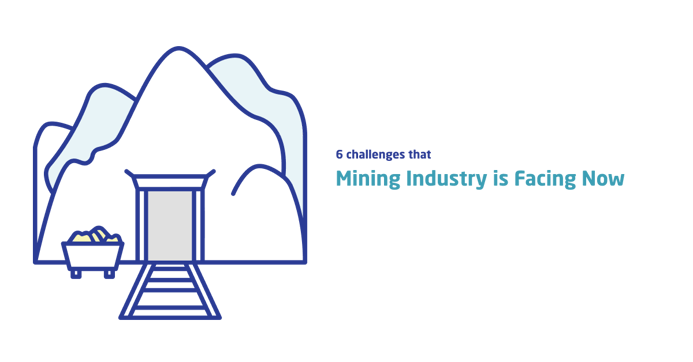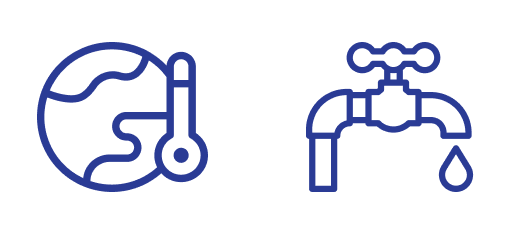
The mining industry all over the world is facing complex challenges from all directions. Environmental and climate change pressures, trade wars and geopolitics, changing and uncertain demand, technology changes, and a global maintenance skills shortage to name a few. Addressing these challenges is a priority for the long-term sustainability of mining.
Mining companies and shareholders have to face these challenges head-on or else be left behind in the high-pressure, scrutinized mining sector. Here are the current 6 key challenges that need to be addressed and mitigated by the mining industry:
1. Climate, Social and Environmental Pressures
This is high on the agenda for many industries, but mining is under severe scrutiny. Mining contributes a significant amount to global greenhouse gas emissions and miners are under increasing pressure to decarbonize their operations.
''The mining sector itself will also face pressure from governments, investors, and society to reduce emissions. Mining is currently responsible for 4 to 7 percent of greenhouse-gas (GHG) emissions globally.''
Social and community impact is an increasing focus for shareholders and external stakeholders to ensure local communities are treated fairly and with respect for their human rights - particularly in remote mining sites. Local communities seek economic and social growth but want to ensure that mining companies leave a lasting positive legacy after mining comes to an end.

Water is another key challenge for mining companies. This already scarce resource is required for mining operations in water-stressed areas and is predicted to worsen significantly in coming decades across the Western US, Northern Chile, Central Asia, and Eastern Australia.
To stay competitive, miners must do more to address climate, social and environmental challenges in the corporate strategies, reporting, and high-level decision-making. As an Ernst & Young report urges: ‘Miners that can demonstrate their contribution to a sustainable future will have a competitive advantage, the time to act is now.
2. Health & Safety
Whether it’s open-pit or underground, mining is a risky business in terms of the health and safety of employees. The extractive industries have always been this way. The risks haven’t changed a great deal over the decades and aren’t likely to over the long term. However, nowadays, the industry has a new approach to mitigate the likelihood of the risks: digitalization and connectivity. One example is geo-location tools that help organizations understand the immediate physical location of underground employees (using smartphones or wearables) in relation to hazards such as large vehicles and gases. Several companies are working to develop electric trolley systems to replace the high emission and noisy diesel systems.

3. Geopolitics
This has come to the fore increasingly since the Covid-19 pandemic. Colder relations between the West and China, the war in Ukraine, and European Union instability have all directly and indirectly affected the mining sector. The emergence of new governments and resource nationalism often means short-term political instability, and global trade conflicts may appear in different regions of the world. One of the after-effects of the instability and trade wars are increased supply chain risks in terms of raw materials, spare parts, technology, and the resultant increased costs. The demand for Lithium due to the sharp increase in electric vehicles and battery technology is a clear example of commodity price increase risks.
''The geopolitics of natural resource access and management is critical for the metals and mining sector. Geopolitical tensions affect demand-side indicators. Conflicts can lead to a decline in demand for new investments and, therefore, the demand for raw materials.''

Mining companies will need to be proactive in dealing with geopolitical issues such as trade wars, resource nationalism, and political upheaval. This will require a multi-faceted approach that actively engages with suppliers, governments, and trade bodies to ensure that the long-term supply chain is sufficiently robust.
4. Demand Insecurity
The challenge for mining companies is to build a flexible business that can deal with fluctuations from unstable prices, uncertain demands, and the threat of product substitution.
The worldwide transition to renewable energy sources is gradually increasing the demand for those minerals and materials necessary for battery storage and electric vehicles. In order to square up to this supply challenge, mining operators will need to overcome the barriers to accessible capital, getting a license to operate (LTO), and operating in a small number of global markets where the minerals are found.
As with the almost daily advances in technology, miners have to be constantly aware of the threat of substitution on long lead time projects in particular. For example, as the energy transition evolves, there may be changes in demand for specific commodities, and often times miners cannot keep pace. The best-in-class miners optimize their risk profiles by using scenario modeling to predict any impact on changing demand and may also implement offtake agreements to deal with the threat of price volatility.
5. Constant Innovation and Technology Change
As mentioned earlier, in terms of health and safety, innovation and technology is a source of constant challenge and change, with digital innovation being at the forefront of current change in most industries. Mining companies are attempting to drive change to address the current issues associated with increasing productivity, improving safety records, and lessening the risk to the environment.
''Mining companies are not well-known as technological disruptors. But there is a mandate now to invest more in technology to come up with solutions to the challenges of today — from ESG to productivity to ways of lowering costs.''
Manuel Fernandes, KPMG in Brazil

The challenge for miners is to adopt the asset management approach to use data modeling and scenario planning as decision-making tools to deliver long-term value from their asset base. The leading miners in the field are using digital technology to run remote operating centers and make significant cost savings by having subject matter experts ‘dial in’ their expertise. Automation and health and safety reporting are also key areas improving through digital transformation. New technologies are improving many aspects of mining: they are minimizing ground disturbance and the impact on wildlife and the surrounding environment; drones are being used for aerial surveys, and sensors are improving productivity and highlighting impending asset failures.
The current challenge for senior mining stakeholders is to keep pace and keep investing in innovation and technology where the efficiency and productivity gains are proven.
6. Maintenance Skills Shortage
The maintenance skills and talent shortage in mining is a worldwide phenomenon, not just in the US. Mining companies are suffering a skills crisis as travel restrictions and an industry often perceived as unattractive make it difficult to locate and retain the right talent. It had already been building before the COVID-19 pandemic, but the worldwide lockdowns deepened the issue. The key challenge for the mining industry is how to attract and retain maintenance talent in a sector that is unfashionable to younger generations, perceived as damaging to the environment, and dirty and hard physical work.
The focus must be on an inclusive and open culture with solid career paths open to everyone. And this means improvement in working conditions, benefits, culture, and the opportunity for remote working and training.
Just like most industries, mining is facing significant changes and challenges in the 2020s, which means businesses have to balance the risks and costs to stay ahead of their competitors. The crucial challenges discussed here show the need to be agile, ready for change, and continuously strive for excellence in all parts of the mining operations.






